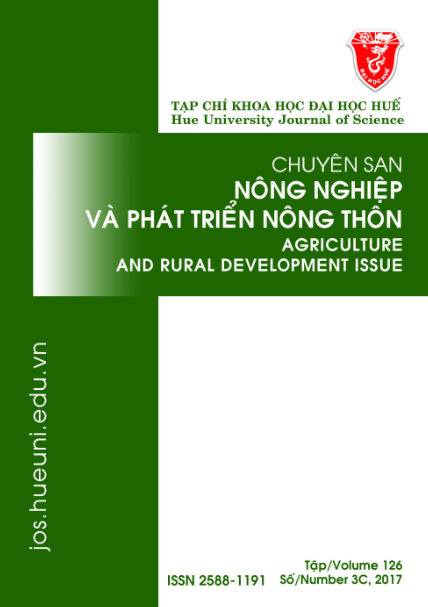Tóm tắt
Thí nghiệm xác định ảnh hưởng của độ mặn đến thành phần loài và số lượng vi khuẩn Vibrio spp. trong nước và cơ thể tôm thẻ chân trắng đã được tiến hành tại Quảng Trị trên 06 ao nuôi với diện tích 2.500 m2 mỗi ao, thí nghiệm gồm 2 nghiệm thức tương ứng 2 độ mặn 13±2‰ và 27±2‰ với 3 lần lặp lại. Mẫu nước và tôm được thu 10 ngày một lần cho đến 120 ngày nuôi để xác định thành phần và số lượng vi khuẩn Vibrio spp. Kết quả cho thấy, ở hai nghiệm thức đều có sự xuất hiện của các loài vi khuẩn như nhau nhưng khác nhau về số lượng. Vào tháng thứ nhất chỉ có 1 loài (V. Alginolyticus), tháng thứ 2 có 2 loài (V. alginolyticus và V. parahaemolyticus) đến tháng thứ 3 và 4 có 3 loài (V. alginolyticus, V. parahaemolyticus và V. harveyi). Số lượng vi khuẩn Vibrio spp. tăng dần theo thời gian nuôi và ở môi trường có độ mặn cao số lượng vi khuẩn trong môi trường nước và trên cơ thể tôm cao hơn môi trường có độ mặn thấp (p<0,05). Vì vậy, nuôi tôm thẻ chân trắng ở độ mặn thấp có thể hạn chế sự gây bệnh của vi khuẩn Vibrio spp.
Tài liệu tham khảo
- Ching C., Portal J., Salinas A., (2014), Low - salinity culture water controls vibrios in shrimp post larvae, The global aquaculture advocate, 26 - 27.
- Huervana F. H., De la Cruz J. J. Y., Caipang C. M. A. (2006), Inhibition of luminous Vibrio harveyi by green water obtained from tank culture of tilapia, Oreochromis mossambicus, Acta Ichthyologica et piscatoria, 36, (1), 17 - 23.
- Loc H. T, Fitzsimmons, M. K & Lightner, D. V., 2013. Effects of tilapia in controling the Acute Hepatopancreatic Necrosis Disease ( AHPND) - Aquacultural Engineering Society - Biofloc Technology Working Group. Workshop on Biofloc Technology and Shrimp Diseases. December 9-10, 2013 Ho Chi Minh City, Vietnam.
- Moriarty D. J. W. (1999), Disease control in shrimp Aquaculture with probiotic bacteria, Microbial Interactions in Aquaculture, 1 - 7.
- Orozco L. N., Félix E. A., Ciapara I. H., Flores R. J., Cano R., 2007. Pathogenic and non pathogenic Vibrio species in aquaculture shrimp ponds, Rev Latinoam Microbiol 2007; (49) 60-67.
- Tendencia, E. A., Bosma, R. H., Verdegem, M. C. J., & Verreth, J. A. J. (2015). The potential effect of greenwater technology on water quality in the pond culture of Penaeus monodon Fabricius. Aquaculture Research, 46(1), 1-13.
- Valderrama D., Anderson J. L. 2011. Shrimp production review. Global Outlook for Aquaculure Leadership. Shrimp production survey: Issues and Challenges. Santiago, Chile, November 6-9, 2011.
- Xu W. J., Pan L. Q. 2013. Enhancement of immune response and antioxidant status of Litopenaeus vannamei juvenile in bioflocs-based culture tanks manipulating high C/N ratio of feed input. Aquaculture. 412-413: 117-124.
- Zorriehzahra M. J., Banaederakhshan, R. (2015). Early mortality syndrome (EMS) as new emerging threat in shrimp industry. Advances in Animal and Veterinary Sciences 3(2s): 64-72.
- Zulkifli Y., Alitheen N. B, Son R., Yeap S. K., Lesley M. B., Raha A. R. (2009), Identification of Vibrio parahaemolyticus isolates by PCR targeted to the toxR gene and detection of virulence genes, International Food Research Journal, (16) 289 - 296.
